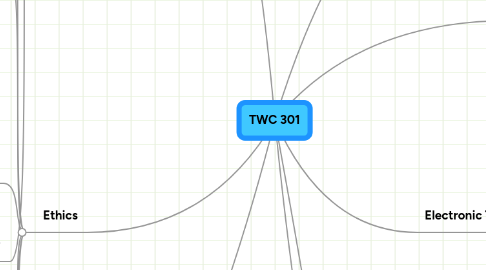
1. Rhetoric & Tech Comm
1.1. Elements
1.1.1. Exigency and Purpose
1.1.1.1. Defined
1.1.1.1.1. http://encarta.msn.com/dictionary_1861609760/exigency.html
1.1.1.2. Purposes
1.1.1.2.1. Inform
1.1.1.2.2. Define
1.1.1.2.3. Explain
1.1.1.2.4. Propose
1.1.1.2.5. Convince
1.1.2. Audiences
1.1.2.1. Audiences Vary
1.1.2.1.1. Classified By...
1.1.2.2. Expectations/Attitudes
1.1.2.2.1. Positive
1.1.2.2.2. Negative
1.1.2.2.3. Neutral
1.1.2.3. Documents
1.1.2.3.1. Used To...
1.1.2.3.2. Know Audience
1.1.2.4. Multiple Audiences
1.1.2.4.1. Use Sections
1.1.2.5. Cross-Cultural
1.1.2.5.1. Different Needs
1.1.2.5.2. http://www.kwintessential.co.uk/cultural-services/articles/intercultural-communiction-global-workplace.html
1.1.3. Workplace Writers
1.1.3.1. Correctness
1.1.3.2. Experience/Expertise
1.1.3.3. Goodwill
1.1.3.4. Similarity
1.1.3.5. Trust
1.1.4. Documents
1.1.4.1. Defined
1.1.4.2. Types
1.1.4.2.1. Memos
1.1.4.2.2. Emails
1.1.4.2.3. Proposals
1.2. Misconceptions
2. Ethics
2.1. Codes of Ethics
2.2. What is Ethics?
2.2.1. Respect Confidentiality
2.2.2. Be Honest!
2.2.3. Legal Vs. Ethical
2.2.3.1. Liability Laws
2.2.3.2. Environmental Laws
2.2.3.3. Copywright
2.2.3.4. Patent
2.2.3.5. Trademark
2.2.3.6. Contracts
2.3. Ethics and Tech
2.3.1. Email
2.3.1.1. Privacy
2.3.1.1.1. Email Monitoring
2.3.1.2. True or False?
2.3.2. Websites
2.3.3. Visuals
2.3.4. Laws of Cyberspace
2.3.4.1. Laws
2.3.4.2. Social Norms
2.3.4.3. The market
2.3.4.4. Architecture (of the Web)
2.4. Environmental Ethics
2.4.1. Natural Environment
2.4.1.1. http://www.organicconsumers.org/monsanto/roundup.cfm
2.4.2. Community Environment
2.4.3. Business Environments
2.4.4. Academic Environments
2.5. Unethical Writing
2.5.1. Deceptive/Evasive Language
2.5.2. Obscuring the Issue
2.5.2.1. Abstract Language
2.5.2.1.1. As Opposed to Concrete
2.5.2.2. Jargon
2.5.2.3. Emphasis/Supression
2.5.2.4. Visual Rhetoric
2.5.2.5. Plagiarism
2.5.2.6. Inaccurate Info
2.6. Ethics Toolkit
2.6.1. http://www.ethics.org/page/ethics-toolkit
3. Organizing & Drafting Docs
3.1. Predrafting
3.1.1. Confirm your purpose
3.1.1.1. TWC: Purpose
3.1.1.1.1. See note:
3.1.2. Analyze your audience
3.1.2.1. TWC: Audience
3.1.2.1.1. See note:
3.1.3. Gather your info
3.1.4. Develop ideas about the info
3.1.5. Organize your info
3.1.5.1. Sequential
3.1.5.2. Chronological
3.1.5.3. Order of importance
3.1.5.4. General/specific
3.1.5.5. Division
3.1.5.6. Classification
3.1.5.7. Cause and effect
3.1.5.8. Compare/contrast
3.1.5.9. Spatially
3.1.6. Outline Important Ideas
3.2. Writing the draft
3.2.1. Front matter
3.2.1.1. Drafting the introduction
3.2.1.1.1. Scope
3.2.1.1.2. Statement of the problem
3.2.1.1.3. Relevant info
3.2.1.1.4. Key terms
3.2.1.1.5. Overview of organization
3.2.2. Body
3.2.2.1. Drafting the body
3.2.3. End matter
3.2.3.1. Drafting the conclusion
4. Technical Instructions
4.1. Ethics
4.1.1. Functionality
4.1.2. Safety
4.1.3. Misuse of product
4.1.4. Hazards
4.1.5. Troubleshooting
4.1.6. Product liability
4.2. KEY ELEMENTS
4.2.1. Title & title image
4.2.2. Byline
4.2.3. Date
4.2.4. Intro
4.2.5. Alerts
4.2.6. Equipment needed
4.2.7. Parts list
4.2.8. Steps
4.2.8.1. Number each step
4.2.8.2. Perform all steps as you draft them
4.2.8.3. Begin each step with a verb
4.2.8.4. Use positive commands
4.2.8.5. Avoid highly condensed language
4.2.8.6. One action per step!
4.2.8.7. Group similar steps together
4.2.8.8. Visually separate steps
4.2.8.9. Clarify with visuals
4.2.8.10. Conclusion
4.2.8.10.1. Troubleshooting
4.2.8.10.2. Maintenance
4.2.8.10.3. Additional alerts
4.2.8.11. Quick reference card
4.2.8.12. Help
4.2.8.12.1. Be concise, throrough
4.2.8.12.2. Be direct but friendly
4.2.8.12.3. Provide examples, links
5. Writing in Workplace
5.1. As A Document
5.1.1. Professional
5.1.2. Clear and Correct
5.1.3. Aware of Audience
5.1.3.1. Interviewing Audience: Handbook of Tech Writing p. 271
5.1.4. Concise
5.1.5. Rhetorical
5.1.6. Ethical
5.1.6.1. http://investor.google.com/corporate/code-of-conduct.html
5.1.6.2. Ethics: Handbook of Tech Writing p. 178
5.1.7. Technology Oriented
5.1.7.1. Emails: Handbook of Tech Writing p. 162
5.1.7.2. Instange Messaging: Handbook of Tech Writing p. 256
5.1.8. Visual
5.1.8.1. http://www.onlinecharttool.com/
5.1.8.2. Visuals: Handbook of Tech Writing p. 553
5.1.9. Research Oriented
5.2. As An Activity
5.3. As Problem Solving
5.3.1. "Problem"
5.3.1.1. External Problems
5.3.1.2. Rhetorical Problems
5.3.2. PSA: Problem-Solving Approach
5.3.2.1. Plan
5.3.2.2. Research
5.3.2.3. Draft
5.3.2.4. Revise
5.3.2.5. Distribute
6. Electronic Technologies
6.1. Impact
6.2. Creating Docs
6.2.1. Word Processors
6.2.2. Web-Authoring Software
6.2.2.1. Webpages
6.2.2.1.1. Benefits
6.2.2.1.2. Web Design For People With Disabilities
6.2.2.1.3. Writing For Global Audience
6.2.3. Graphics & Imaging Software
6.2.3.1. Photoshop, Etc.
6.2.4. Desktop Publishing Software
6.2.4.1. InDesign, Etc.
6.3. Communicating and Collaborating
6.3.1. The Internet
6.3.1.1. Intranets
6.3.2. Email
6.3.2.1. Advantages
6.3.2.1.1. Speed
6.3.2.1.2. Price
6.3.2.1.3. Convenience
6.3.2.1.4. Organization
6.3.2.2. Sending Attachments
6.3.2.2.1. Handbook of Tech Writing p. 164
6.3.3. Remotely
6.3.3.1. Conducting Meetings
6.3.3.1.1. Handbook of Tech Writing p. 328
6.3.4. Global Communication
6.3.4.1. New node
6.4. Ethics
6.4.1. Netiquette
6.4.1.1. Choose Appropriate Email Address
6.4.1.2. Polish Writing
6.4.1.3. Back Up & Save
6.4.1.4. "When It's Out There, It's Out There"
7. Transnational/Transcultural Audiences
7.1. Meanings
7.1.1. Transnational - global community without national borders.
7.1.2. Suggest a sense of movement, particularly the flow of ideas, goods, and services and the flow of communication and in-formation.
7.1.3. Connectivity despite differences.
7.2. Writing For
7.2.1. Learn About Differences
7.2.1.1. Language
7.2.1.2. Tech.
7.2.1.3. Education
7.2.1.4. Politics/law
7.2.1.5. Econ.
7.2.1.6. Society
7.2.1.7. Religion
7.2.2. Avoid Stereotypes
7.2.2.1. Avoid assumptions
7.2.2.2. Ask questions
7.2.2.3. Collaborate with translator
7.2.3. Translation
7.2.3.1. No unfamiliar terminology
7.2.3.2. Clarity
7.2.3.2.1. HTW: Gender
7.2.3.2.2. HTW: Clarity
7.2.3.3. No idioms, humor
7.2.4. Be Accomodating
7.2.4.1. Localization
7.2.4.1.1. ???
7.2.4.2. Internalization - adapting documents to target audience(s)
7.2.4.3. Globalization
7.2.4.3.1. A global document is one that can be read and understood by as many transnational and transcultural audiences as possible.
7.2.5. Writing Guidelines
7.2.5.1. Write clearly and correctly
7.2.5.2. Localize your writing
7.2.5.2.1. HTW: International Correspondence
7.2.5.3. Be aware of visual, auditory perceptions
